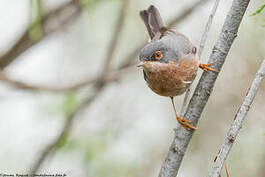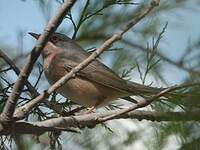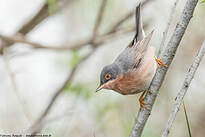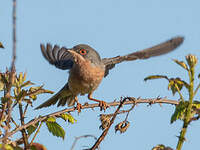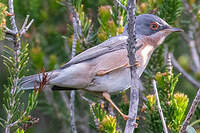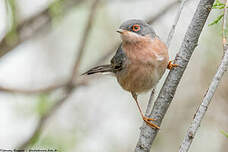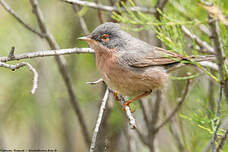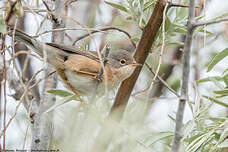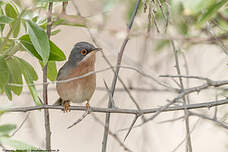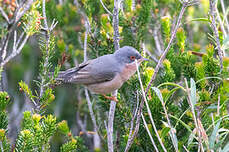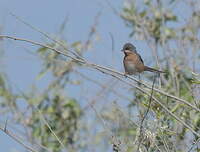Moltoni's Warbler
Curruca subalpina - Fauvette de Moltoni
Identification
Recent genetic studies have completely changed the systematic of the passerinette warbler. These studies have shown that we were not dealing with a single species, but with three species that had sufficient differences in genetics, appearance, and vocalization. The latest studies show that Moltoni's Warbler is a monotypic taxon (no subspecies).
Of the three species in the passerinette group, it is the one whose male has the widest and least intensely-colored lower parts, the salmon-pink color extending from the throat to the lower abdomen. The upperparts are bluish gray, slightly tinted with brownish. The remiges are blackish with a thin rusty brown border. The rectrices are very dark brown or even blackish, the outer ones widely bordered with white. A sharp white moustache is visible between the side of the head and the throat. The orbital ring is dark pink/reddish.
It is distinguished from the other two passerinette males by the pinkish-salmon colour of the underside and not orange-brown in Sylvia cantillans and by the extent of this colouring in Sylvia inornata/iberiae. The females are much harder to differentiate, except for the call (see further).
Subspecific information monotypic species
Foreign names
- Fauvette de Moltoni,
- Curruca subalpina,
- toutinegra-subalpina,
- Ligurien-Bartgrasmücke,
- Moltoni's Baardgrasmus,
- Sterpazzolina di Moltoni,
- moltonisångare,
- Maquissanger,
- penica Moltoniho,
- pěnice ligurská,
- Makisanger,
- rätinärusokerttu,
- tallarol de garriga,
- pokrzewka różowobrzucha,
- Славка Молтони,
- アコウザンムシクイ,
- 地中海林莺,
- moltonisångare,
- 摩氏林鶯,
Voice song and call
The call is very different from that of the Lesser Whitethroat and alone allows good identification. It is a great help when dealing with female or young ones. It consists of a rather short trill trrrr or trrri that resembles a bit to that of the Long-tailed Tit (or the Cute Wren).
As with that of the Lesser Whitethroat, the song is short and includes both sharp and wet notes between which the call is often inserted.
Habitat
During breeding season, Moltoni's Warbler mainly frequents low-lying habitats, such as garrigue or maquis, interspersed with taller trees such as Holm oaks. In Corsica, it also inhabits higher maquise in maritime pine stands. It breeds from the coast (including on small islands) and reaches up to 1,600 metres in the Apennines.
In wintering grounds, it frequents acacia savannas, tamarisks along oueds, and even mangroves. During migration, it can be seen in all kinds of vegetation.
Behaviour character trait
Most species found in this type of habitat are best contacted through their sound emissions, as they rarely leave the thick, low shrubs.
However, at the beginning of the breeding season, males sometimes embark on brief nuptial flights, rising above the vegetation before settling at the top of a shrub or even a tree. When adults are feeding their young in the nest, they become more visible as they search for prey in trees with less dense foliage.Moltoni's Warbler is a migratory species, wintering in the Sahel, likely in a band extending from southern Mauritania to Nigeria. They leave their breeding sites between August and early October, with some stragglers staying until the end of the month. The first birds return at the end of March in southern Italy, usually two or three weeks after the first Pied Warblers. In Corsica, the nesting birds arrive at the beginning of April.
Dietfeeding habits
We don't know much about the diet of this small warbler, except that it is mainly insectivorous but, before migrating, it also consumes berries. Probably its diet is similar to that of the Common Chiffchaff.
Reproduction nesting
The nest is a well-hidden cup at the heart of low (and often thorny) vegetation. Clutches are laid from late April to late June with a maximum in the first half of May in Corsica and on the Isle of Elba, and at the end of May in the northern Apennines.
They contain 3 to 5 eggs, with, for example, an average of 3.8 eggs/clutch (52 clutches from the province of Parma) or 3.7 eggs/clutch (for Moltoni's Warbler clutches in Corsica). incubation is carried out by both adults and lasts around twelve days. The chicks, fed by both parents, also remain in the nest for about twelve days and are fed for a few days after leaving the nest.Geographic range
Moltoni's Warbler has a very restricted breeding range: Sardinia, Corsica, a few small islands of the Tyrrhenian Sea, Tuscany, northern part of the Apennines, central-southern Piedmont and Liguria. During prenuptial migration, it is frequently observed on the Mediterranean coast of France (Provence, Cote d'Azur, Languedoc-Roussillon).
Threats - protection
IUCN conservation status
concern
in the Wild
threatened
evaluated
Moltoni's Warbler, quite common in its breeding range, does not seem to be threatened even though its numbers are not very high. In Italy, numbers are estimated between 50,000 and 130,000 pairs. It is not known what the numbers are in Corsica.
Sources of information
- IOC World Bird List (v14.2), Gill, F and D Donsker (Eds). 2024-04-18.
- HBW Alive,
- Atlas des oiseaux de France métropolitaine. Nidification et présence hivernale. , Issa Nidal et Muller Y
- Ornitologia italiana - Vol 6 Sylviidae - Paradoxornithidae, Brichetti P. Fracasso G.
- Sylvia warblers. Identification, taxonomy and phylogeny of the genus Sylvia, Shirihai H., Gargallo G. Helbig A. J.
- The birds of Corsica, Thibault J.-C., Bonaccorsi G.
- Type specimens matter: New insights on the systematics, taxonomy and nomenclature of the Subalpine Warbler (Sylvia cantillans) complex, Zuccon D., Pons JM., Boano G., Chiozzi G., Gamauf A., Mengoni C., Nespoli D., Olioso G., Pavia M., Pellegrino I., Rakovic M., Randi E. et al
Other sources of interest
 Specification sheet created on
30/07/2023 by Georges Olioso
Specification sheet created on
30/07/2023 by Georges OliosoTranslation by AI Oiseaux.net
© 1996-2025 Oiseaux.net
- Accipitriformes
- Aegotheliformes
- Anseriformes
- Apodiformes
- Apterygiformes
- Bucerotiformes
- Caprimulgiformes
- Cariamiformes
- Casuariiformes
- Charadriiformes
- Ciconiiformes
- Coliiformes
- Columbiformes
- Coraciiformes
- Cuculiformes
- Eurypygiformes
- Falconiformes
- Galliformes
- Gaviiformes
- Gruiformes
- Leptosomiformes
- Mesitornithiformes
- Musophagiformes
- Nyctibiiformes
- Opisthocomiformes
- Otidiformes
- Passeriformes
- Pelecaniformes
- Phaethontiformes
- Phoenicopteriformes
- Piciformes
- Podargiformes
- Podicipediformes
- Procellariiformes
- Psittaciformes
- Pterocliformes
- Rheiformes
- Sphenisciformes
- Steatornithiformes
- Strigiformes
- Struthioniformes
- Suliformes
- Tinamiformes
- Trogoniformes








